



One Water Approaches to Complex Problems W. Shane Walker, Deana Pennington, Bill Hargrove, Ivonne Santiago, Ed Archuleta, and Malynda Cappelle April 24, 2019
CONTEXT: GLOBAL WATER ISSUES
United Nations Sust. Devl. Goals http://www.globalgoals.org/
Goal 6 Targets: By 2030 • achieve universal and equitable access to safe and affordable drinking water for all • achieve access to adequate and equitable sanitation and hygiene for all and end open defecation, paying special attention to the needs of women and girls and those in vulnerable situations • expand international cooperation and capacity-building support to developing countries in water- and sanitation-related activities and programmes, including water harvesting, desalination, water efficiency, wastewater treatment, recycling, and reuse technologies
Related UNSD Goals
Challenges in semi-arid regions • Changing climate & competing demands • Growing population, urban, & indust. demand • Inequitable distribution & cost of water • Agriculture uses majority of water; dwindling groundwater Agriculture • Lack of environmental flows Environmental Flows Urban • Increasing salinity Social Industrial Justice
STRATEGY: “ONE WATER” PARADIGM A “One Water” approach is called for, one that is holistic, comprehensive, and integrated to meet the challenges of the 21st century.
One Water Paradigm We consider all water sources as part of One Water supply (precipitation, groundwater, wastewater, gray water, return flows, recharge, etc.), and we optimize the processes of recycling and reuse. We manage surface and groundwater as One Water through conjunctive water use approaches. We share One Water among several important sectors of users: agriculture, urban, industrial, environmental, and rural residents who lack adequate access to water. We share One Water among two countries, three states, and three major cities; we must find practical approaches to transboundary water management for the 21 st century.
One Water Consortium Goal • Transform water sustainability in semi- arid regions around the world by forging innovative One Water strategies and practical approaches for all uses • “sustainable water”: adequate, affordable, acceptable, usable, safe, clean
One Water Objectives • Catalyze societal capacity to innovate and adapt flexibly to an uncertain water future • Transform water infrastructure in cities to provide the best quality water for the highest use • Empower rural and developing communities for a water-secure future • Re-envision conventional agriculture as food, energy, and water smart systems • Re-imagine river systems to restore environmental flows and services
Catalyze societal capacity to innovate and adapt flexibly to an uncertain water future • Stakeholder engagement • Participatory modeling with data and models • Decision-making in volatile, uncertain, complex, and ambiguous (VUCA) contexts • Holistic approaches that include technical and non- technical options • Science to action – science-informed policy making
Transform water infrastructure in cities to provide the best quality water for the highest use • Smart treatment technologies/systems (self-sensing, very high reliability, automated, simple to maintain) • Using impaired water (desalination, potable reuse, produced water, etc.) • Sharing/trading water between/ among sectors • Stormwater capture • Aquifer recharge and storage
Empower rural and developing communities for a water-secure future • Soft path to water – non-traditional, distributed, integrated • Small, distributed water and wastewater treatment units • Technical support and information- sharing among small communities/utilities
Re-envision conventional agriculture as food, energy, and water smart systems • Optimize the efficiency and use of decentralized desalination • Renewable energy integration • Crop efficiency • Water-smart farming considering nutrients and conservation • Water and soil salinity/quality • Stormwater capture and management during high flows
Re-imagine river systems to restore environmental flows and services • Natural treatment systems • Mimic natural flows – paths, volumes, and timing • Celebrate the intangible benefits of riparian wetlands.
Challenge • Many of these elements have already been seeded in the Paso del Norte region and need to be nurtured to greater maturity and impact. • Some of these elements need champions to adopt and implement. • We invite you to partner with us to fully operationalize this paradigm.
Recommend
More recommend